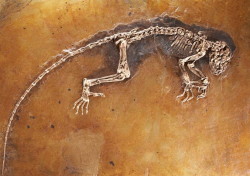
Photo. The 47 million year fossil Ida. © The Natural History Museum at the University of Oslo. Naturhistorisk Museum, Universitetet i Oslo. Website: www.nhm.uio.no
Discovered in Messel Pit, Germany, the fossil is twenty times older than most fossils that explain human evolution. This is according to a Press Release 19 May 2009 from The Natural History Museum at the University of Oslo and the Senckenberg Research Institute Receal Landmark Scientific Find. Sources: www.nhm.uio.no and www.revealingthelink.com
The fossil is a transitional species showing characteristics from the very primitive non-human evolutionary line (prosimians, such as lemurs), but she is more related to the human evolutionary line anthropoids, such as monkeys, apes and humans).
This places Ida at the very root of anthropoid evolution when primates were first developing the features that would evolve into our own.
The scientists findings are published today by PLoS ONE, the peer reviewed open access journal from the Public Library of Science. For the past two years, an international team of scientists, led by world-renowned Norwegian fossil scientist Dr Jørn Hurum, University of Oslo Natural History Museum, has secretly conducted a detailed forensic analysis of the extraordinary fossil, studying the data to decode humankind s ancient origins. At 95% complete, Ida is set to revolutionise our understanding of human evolution.
Unlike Lucy and other famous primate fossils found in Africa s Cradle of Mankind, Ida is a European fossil, preserved in Germany s Messel Pit; the mile-wide crater and oilrich shale is a significant site for fossils of the Eocene Epoch. Fossil analysis reveals that the prehistoric primate was a young female. Opposable big toes and nails confirm the fossil is a primate, and a foot bone called the talus bone links Ida directly to humans.
The fossil also features the complete soft body outline as well as the gut contents; a herbivore, Ida feasted on fruits, seeds and leaves before she died. X-rays reveal both baby and adult teeth, and the lack of a toothcomb or a toilet claw which is an attribute of lemurs. The scientists estimate Ida s age when she died to be approximately nine months, and she measured approximately three feet in length.
Ida lived 47 million years ago at a critical period in Earth s history. I t fell within the Eocene Epoch, a time when the blueprints for modern mammals were being established. Following the extinction of dinosaurs, early horses, bats, whales and many other creatures including the first primates thrived on a subtropical planet.
The Earth was just beginning to take the shape that we know and recognise today the Himalayas were being formed and modern flora and fauna evolved. Land mammals, including primates, lived amid vast jungle.
Ida was found to be lacking two of the key anatomical features found in lemurs: a grooming claw on the second digit of the foot, and a fused row of teeth in the middle of her lower jaw known as a toothcomb. She has nails rather than the claw typical of non-anthropoid primates such as lemurs, and her teeth are similar to those of monkeys. Her forward facing eyes are like ours which would have enabled her fields of vision to overlap, allowing 3D vision and an ability to judge distance.
The fossil`s hands show a humanlike opposable thumb. Like all primates, Ida has five fingers on each hand. Her opposable thumb would have provided a precision grip . In Ida`s case, this is useful for climbing and gathering fruit; in our case, it allows important human functions such as making tools, and writing.
Ida would have also had flexible arms, which would have allowed her to use both hands for any task that cannot be done with one like grabbing a piece of fruit. Like us, Ida also has quite short arms and legs.
Evidence in the talus bone links Ida to us. The bone has the same shape as in humans today. Only the human talus is obviously bigger. X-rays, CT scanning and computer tomography reveal Ida to be about nine months old when she died, and provide clues to her diet which included berries and plants. Furthermore the lack of a bacculum (penis bone) means that the fossil was definitely female.
X-rays reveal that a broken wrist may have contributed to Ida s death her left wrist was healing from a bad fracture. The scientists believe she was overcome by carbon dioxide gas whilst from drinking from the Messel lake: the still waters f the lake were often covered by a low lying blanket of the gas as a result of the volcanic forces that formed the lake and which were still active. Hampered by her broken wrist, Ida slipped into unconsciousness, was washed into the lake, and sunk to the bottom, where unique preservation conditions preserved her for 47 million years.
Expert Quotes
This fossil is so complete. Everything s there. I t s unheard of in the primate record at all. You have to get to human burial to see something that s this complete.
Dr Jørn Hurum - Natural History Museum, University of Oslo
This fossil will probably be pictured in all the text books for the next 100 years.
Dr Jørn Hurum - Natural History Museum, University of Oslo
This is the first link to all humans truly a fossil that links world heritage.
Dr Jørn Hurum - Natural History Museum, University of Oslo
It`s really a kind of Rosetta Stone.
Professor Philip Gingerich - Museum of Paleontology, University of Michigan
In terms of a complete skeleton, it s hard to think of anything else in primate evolution that s as complete as this fossil.
Dr Holly Smith - Museum of Anthropology, University of Michigan
We have not only the complete skeleton but we have also the complete soft body outline and the gut contents.
Dr Jens Lorenz Franzen - Senckenberg Research Institute
This fossil rewrites our understanding of the early evolution of primates.
Dr Jörg Habersetzer - Senckenberg Research Institute
This little creature is going to show us our connection with all the rest of the mammals.
Sir David Attenborough Broadcaster & Naturalist
The link they would have said until now is missing... it is no longer missing.
Sir David Attenborough Broadcaster & Naturalist
It is incredibly rare to get the opportunity to document groundbreaking science as it happens. Even more exciting is to be involved with breaking the news in conjunction with the scientists and across multiple platforms with a story that connects to every person on the planet.
Anthony Geffen CEO and Executive Producer, Atlantic Productions
The Link
The findings of the two year study will be revealed exclusively by Atlantic Productions in a special documentary film, The Link, to be screened in the US by
History on Monday May 25th, 2009 at 9pm ET/PT. It will be shown in the UK as Uncovering Our Earliest Ancestor: The Link on BBC One on Tuesday May 26th
Natural History Museum University of Oslo at 9pm. The film is also being shown by ZDF in Germany and NRK in Norway. I t will be distributed globally by BBC Worldwide.
A major book, The Link, written by award-winning science writer Colin Tudge will be published in the US and UK by Little, Brown and Company, a division of Hachette Book Group, on Wednesday May 20th.
An interactive, content-rich website about Ida has been launched at www.revealingthelink.com.
The full scientific findings from the study are set out in the freely available paper.
Complete primate skeleton from the middle Eocene of Messel in Germany: morphology and paleobiology published by PloS ONE, the Public Library of Science s interactive open-access journal for the communication of peer-reviewed scientific and medical research. Read the full text of the scientific article at http://dx.plos.org/10.1371/journal.pone.0005723.
For further information, preview DVDs, transcripts, stills or interviews, please contact:
At PloS ONE:
Rebecca Walton - +44 (0) 1223 463333
rwalton@plos.org
At Atlantic Productions:
Rebecca Ellis +44 (0) 20 8735 9318 rebeccae@atlanticproductions.co.uk
James Taylor - +44 (0) 20 8735 9320 / +44 (0) 7754 850052 jamest@atlanticproductions.co.uk
At HL Group, representing History:
Courtney McCraw +1 212 529 5533 x 258 courtney.mccraw@hlgrp.com
Eban Howell +1 212 529 5533 x 222 eban.howell@hlgrp.com
At BBC:
Victoria Asare-Archer - +44 (0) 20 8225 8399 - victoria.asare-archer@bbc.co.uk
At Little, Brown and Company (US):
Michelle Aielli +1 212 364 1223 - michelle.alli@hbgusa.com
At Little, Brown Book Group (UK) :
Tamsin Kitson - +44 (0) 20 7911 8068 - tamsin.kitson@littlebrown.co.uk
info@revealingthelink.com
Presentation:
The Natural History Museum at the University of Oslo is Norway’s most comprehensible natural history collection. For almost 200 years preserved plant specimens, animal specimens, rocks, minerals and fossils have been collected, studied and preserved here.
A selection of specimens are on display for the general public, in the Geological Museum and the Zoological Museum. Both are to be found in the beautiful Botanical Garden. Located at Tøyen in the east of Oslo city centre, the garden is not only popular for recreation, but a scientific collection in itself.












